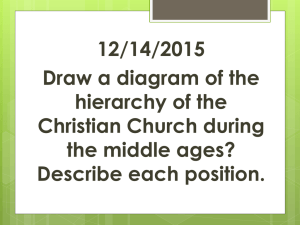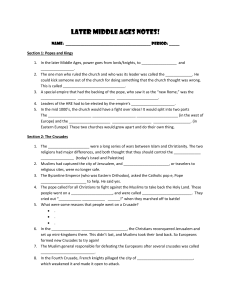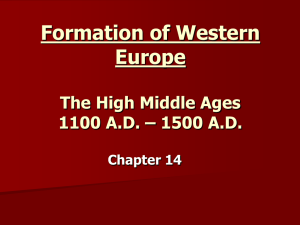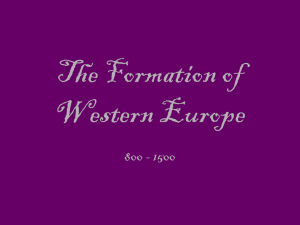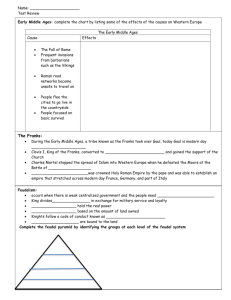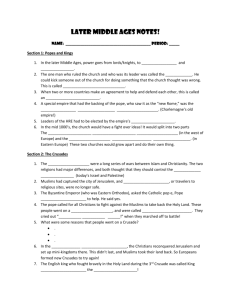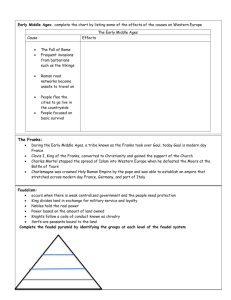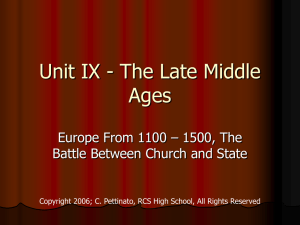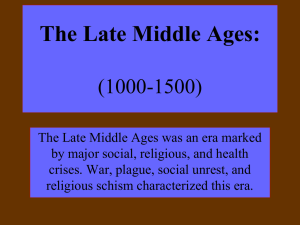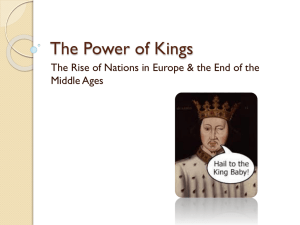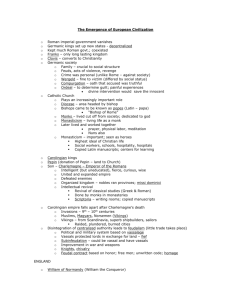During the Late Middle Ages, kings fought with popes, Muslims, and
advertisement
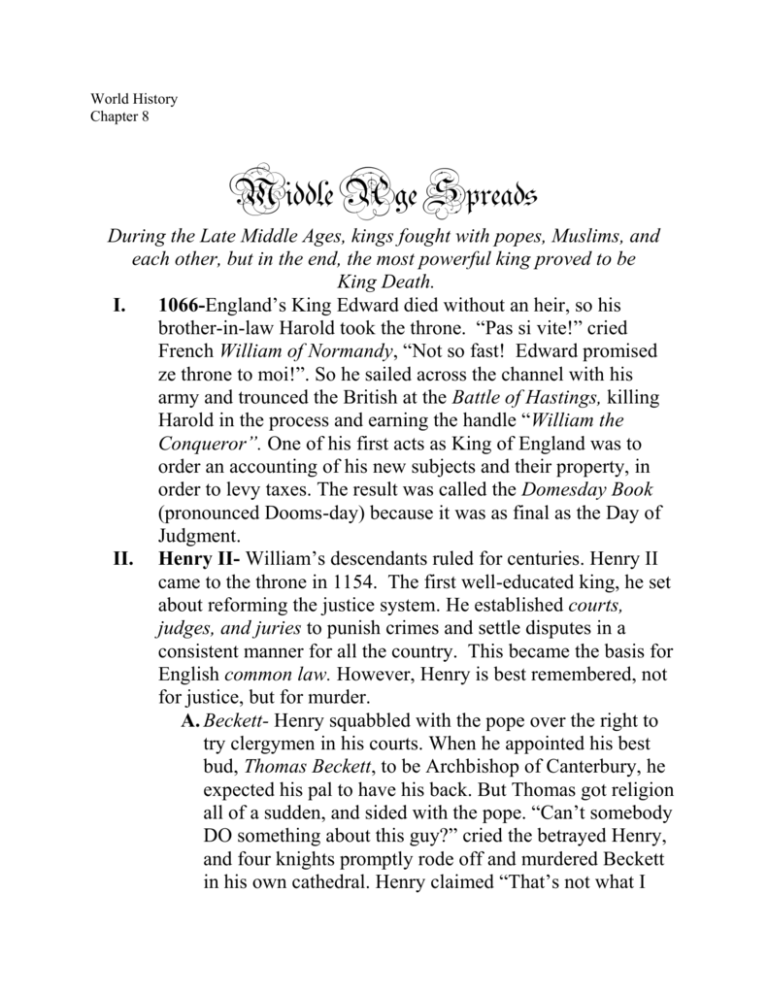
World History Chapter 8 Middle Age Spreads During the Late Middle Ages, kings fought with popes, Muslims, and each other, but in the end, the most powerful king proved to be King Death. I. 1066-England’s King Edward died without an heir, so his brother-in-law Harold took the throne. “Pas si vite!” cried French William of Normandy, “Not so fast! Edward promised ze throne to moi!”. So he sailed across the channel with his army and trounced the British at the Battle of Hastings, killing Harold in the process and earning the handle “William the Conqueror”. One of his first acts as King of England was to order an accounting of his new subjects and their property, in order to levy taxes. The result was called the Domesday Book (pronounced Dooms-day) because it was as final as the Day of Judgment. II. Henry II- William’s descendants ruled for centuries. Henry II came to the throne in 1154. The first well-educated king, he set about reforming the justice system. He established courts, judges, and juries to punish crimes and settle disputes in a consistent manner for all the country. This became the basis for English common law. However, Henry is best remembered, not for justice, but for murder. A. Beckett- Henry squabbled with the pope over the right to try clergymen in his courts. When he appointed his best bud, Thomas Beckett, to be Archbishop of Canterbury, he expected his pal to have his back. But Thomas got religion all of a sudden, and sided with the pope. “Can’t somebody DO something about this guy?” cried the betrayed Henry, and four knights promptly rode off and murdered Beckett in his own cathedral. Henry claimed “That’s not what I meant!” but dropped his issues with the pope. Beckett was named a saint. III. Bad King John-Henry’s heir, Richard the Lion-heart, went off on crusade and got himself captured, so his nasty little brother ruled in his place. King John lost a war with France, got the kingdom placed under interdict, and so over-taxed his nobles that they forced him to sign the Magna Carta. Although it mostly dealt with tax-relief for the nobles, it limited the power of the king. The king must obey the law, not be a law unto himself. The Magna Carta also introduced due process (protection from arbitrary arrest) which evolved into the right of habeas corpus (you can’t be held in prison unless charged with a specific crime). A. Parliament- the Magna Carta said the king couldn’t raise taxes without consulting his advisors. The power of the purse gave them power over the king. These advisors evolved into Parliament, Britain’s legislature. By 1295, two houses were evolving. The House of Lords consists of titled aristocrats, while The House of Commons represents everyday people. IV. France-Although French William had unified Britain through conquest, France was still in the hands of powerful nobles. When the nobles elected minor land-owner and Count of Paris, Hugh Capet, to the throne they never expected that his family would hold it for 300 years! Hugh consolidated power by creating a hereditary monarchy, gaining support of the church, and building an effective bureaucracy. During a dispute with the pope, Philip IV rallied support from the people by creating the Estates General in 1302. This governing body was made up of nobles, clergy and townspeople. But they never got the power of the purse, which gave them less control over the king than the British parliament. V. The Crusades- Jerusalem was in the hands of the Muslim Turks, who prevented Christian pilgrims from visiting the Holy Land. Byzantine emperor Alexius I sent an SOS to Pope Urban. A. The First Crusade-In 1096, Pope Urban II called for thousands of knights to drive the Turks out. The pope was hoping to strengthen the power of the church. He also thought it would be better for Christian knights to bash Turks instead of each other. The knights were looking for a free pass to heaven, along with any cool eastern stuff they could pick up on the way. In the first Crusade, the Christians took Jerusalem (and celebrated by massacring all the city’s Jews and Muslims). B. Later Crusades-The Crusades continued for 200 years. In 1187, Muslim leader Saladin retook Jerusalem. The Christians kept fighting, but it was a long losing battle. The crusaders never took Jerusalem again. However, it wasn’t just a waste of blood and money, as the Crusades had many positive effects on Europe. 1. Trade- the East had all the best stuff, which crusaders brought back with them. Merchants established trade routes, got rich, and expanded the Western economy. 2. Kings- monarchs who sponsored or even led Crusades were admired. They increased their ability to tax the people to fund the holy cause. 3. The Church- Popes gained popularity and power, although it was short-lived. Once the Crusades ended, popes and kings began squabbling again. 4. Knowledge- Travelers wrote of their experiences in the East (most notably Marco…..Polo!) and ended the isolation of Europe. VI. Spain- Muslims known as Moors inhabited most of the Iberian Peninsula. Christian warriors fought to drive the Moors out. Called Reconquista, they slowly pushed the Moors out. A. Ferdinand and Isabella- they unified Spain through marriage and took the last Muslim city, Granada, in 1492 (yes, the same year they paid for Columbus to sail the ocean blue). Isabella wasn’t having any heathens in her newly unified country, and set up the Spanish Inquisition to root out nonChristians. 150.000 Jews and Muslims fled Spain. Those that didn’t leave or convert were burned. VII. The Black Death- Religion couldn’t keep you safe from the greatest power, Plague! The Bubonic plague invaded to Europe in 1347, carried by rats infested with germy fleas. Victims died within 24 hours. One in three Europeans died. A. Religion- Why had God sent the plague? The priests couldn’t explain it; they were dying like everyone else. Desperate people blamed Jews and slaughtered them. Weird cults developed as the world seemed to be coming to an end. It seemed the church no longer had all the answers. B. The Economy- With the death of so many peasants, labor came to a standstill. Once the danger had passed, peasants sought higher wages and better living conditions, undermining the old feudal system. Inflation was out of control. On the other hand, there were fewer people to share with. Survivors inherited from the dead and the middle class was strengthened. VIII. The Hundred Years War- England and France had fought each other over land that had belonged to William the Conqueror. With the increase in trade after the Crusades, both sides wanted control of the English Channel. Throw in patriotism and the egos of kings, and we are in for a long fight! A. Saint Joan- Because of the longbow, the British came close to taking all of France, but they were beaten by an unlikely warrior. Joan of Arc was a 17 year old peasant girl who heard the voices of angels telling her to save France. She managed to convince the desperate Dauphin, Charles VII to put her at the head of the French Army. Frenchmen were inspired by her and began to turn the tide of war. Joan was captured by the English and burned as a witch, but her martyrdom only increased French spirit. The cannon helped as well. The English lost all territory except Calais. B. Impact- The national pride inspired by Joan made French kings more popular and they expanded their power. English kings, however, had to go hat-in-hand to Parliament for the money to fight, so Parliament gained power (power of the purse again). Pushed out of mainland Europe, England looked to trade to expand their power. New weapons were making knights obsolete as kings formed armies of soldiers for hire. All the calamities of the High Middle Ages actually resulted in an improved Europe. Greater trade led to a better standard of living. The labor shortage caused by the plague increased the power of the peasants. Religious questions raised by the plague and the Crusades led to an enlightened way of thinking: you might say… The Renaissance
